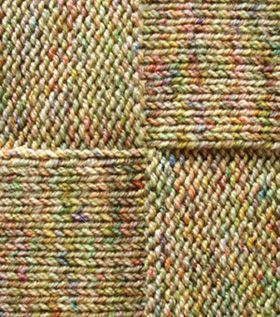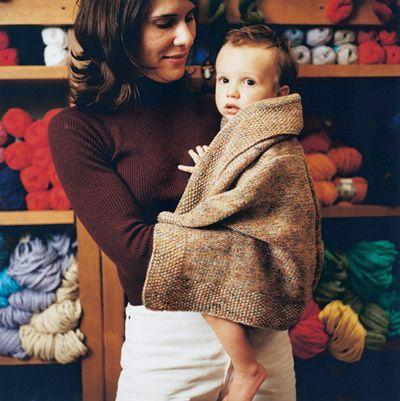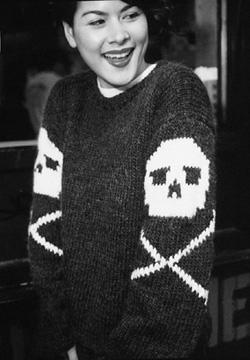Stitch 'n Bitch: The Knitter's Handbook (44 page)
Read Stitch 'n Bitch: The Knitter's Handbook Online
Authors: Debbie Stoller


S
IZE
28" × 28" unblocked; 31" × 31" blocked
M
ATERIALS
Koigu Wool Designs
Painter’s Palette Premium Merino
(100% wool; 50g/175 yds), 8 skeins #P118
US 9 (5.5mm) 29"–40" circular needle, or size needed to obtain gauge
Rust-proof pins for blocking
G
AUGE
18 sts = 4" in St st with 2 strands of yarn held tog
S
TITCH
P
ATTERN
SEED STITCH (EVEN NUMBER OF STS)
Row 1: *K1, p1; rep from * to end of row.
Row 2: *P1, k1; rep from * to end of row.
Rep rows 1–2 for patt.
Note:
You will be working with 2 strands of yarn held tog throughout.
D
IRECTIONS
With 2 strands of yarn held tog, CO 126 sts. Work 20 rows in seed st.
Row 1 (RS): *K1, p1; rep from * 5 times, k53, p53, *k1, p1; rep from * 5 times.
Row 2 (WS): *P1, k1; rep from * 5 times, k53, p53, *p1, k1; rep from * 5 times.
Rep these 2 rows until entire piece meas approx 14" (or until you have finished your 3rd and 4th skeins of yarn). End with a WS row.
Next row (RS): *K1, p1; rep from * 5 times, p53, k53, *k1, p1; rep from * 5 times.
Next row (WS): *P1, k1; rep from * 5 times, p53, k53, *p1, k1; rep from * 5 times.
Rep these 2 rows until entire piece meas approx 25½" (or same number of St st rows as lower half). End with a WS row.
Work 20 rows in seed st.
BO.
FINISHING
Immerse blanket in cool water. Very gently squeeze, then roll the blanket in a towel to absorb excess water. Lay flat on a dry towel. Gently stretch until it meas 31" × 31". Pin with rust-proof pins. Let dry.

ABOUT LISA

I’ve been obsessed with fashion ever since I visited New York’s Fiorucci shop back in the early ’80s while on a weekend shopping trip with my mother. Since then, I have gone to ridiculous lengths to obtain unique fashion finds. Some of my favorite pieces are vintage Courrèges and Vivienne Westwood, and both new and old Yohji Yamamoto. During the ’90s, every Yvonne, Nikki, and Shari was sporting a label, which made me want to create my own one-of-a-kind designs. Since taking up my needles in 1998, I have knit countless sweaters, socks, scarves, and, yes, baby blankets! A couple of years ago, I turned my obsession into a profession and began teaching knitting classes at Rosie’s Yarn Cellar in Philadelphia. I’m a professional astrologer, and my horoscope columns have appeared in several magazines and on
Style.com
. I live in Philadelphia with my baby, Ashby the Chihuahua.
JENNIFER L. JONES
Everyone I know seems to be having a baby these days, so I designed this easy, quick, and inexpensive hat to give as a gift. It can be made with any worsted-weight yarn, but make sure you use something washable that is soft, since babies need garments that don’t itch and that can easily be thrown into the washer. Depending on your gauge, you can probably get two hats from one skein of yarn.

SKILLS | PAGE |
CAST ON | |
KNIT | |
KNIT IN THE ROUND | |
DECREASE | |
I-CORD |
S
IZE
Infant to 6 months
Finished circumference: 16"
M
ATERIALS
Patons
Canadiana
(100% acrylic; 85g/197 yds), 1 skein #81 Gold
US 7 (4.5mm) 16" circular needle, or size needed to obtain gauge
US 7 (4.5mm) double-pointed needles (set of 5)
Stitch markers
G
AUGE
16 sts and 22 rows = 4" in St st (k all rnds)
D
IRECTIONS
Using circular needle, CO 64 sts. K 1 row. Join ends, being careful not to twist the sts. K until hat meas 5" from the CO row.
Next row: *K8, pm; rep from * to end.
You should have 8 groups of 8 sts between 7 markers.
*With a dpn, k 16 sts off the circular needle and onto the dpn, being careful to slip the st marker between the sts; rep from * 3 times more. When you reach the end of the row, you will have placed 16 sts and 1 marker on each of 4 dpns.
Now, in each successive rnd, you will k tog the last 2 sts before the marker or the end of the needle as foll:
Rnd 1: *K6, k2tog; rep from * to end of rnd—56 sts.
Rnd 2: *K5, k2tog; rep from * to end of rnd—48 sts.
Rnd 3: *K4, k2tog; rep from * to end of rnd—40 sts.
Rnd 4: *K3, k2tog; rep from * to end of rnd—32 sts.
Rnd 5: *K2, k2tog; rep from * to end of rnd—24 sts.
Rnd 6: *K1, k2tog; rep from * to end of rnd—16 sts.
Rnd 7: *K2tog; rep from * to end of rnd, remove markers—8 sts.
Rnd 8: *K2tog; rep from * to end of rnd—4 sts.
Slip rem 4 sts onto one dpn. Knit 6" of I-cord. Break yarn, thread it onto a yarn needle, and pull the length through the remaining 4 stitches, drawing the I-cord to a close, then draw the loose end down inside the I-cord to finish. Tie the I-cord into a knot and weave in any loose ends.

ABOUT JENNIFER

I come from a long line of knitters. My grandmother loves to tell about how, at age four, she would walk around the neighborhood knitting. Compared to her, I was a latecomer to knitting, but now I knit almost daily. I knit to relax or while chatting with friends over coffee, so I prefer projects that don’t require too much concentration. The attraction of knitting, for me, is designing patterns with differing levels of challenge and then working them up in a variety of yarns.
SAMANTHA BLISS
The first time I made this sweater, I used slubby dark brown and cream yarn that I’d found in a local yarn shop on sale for one dollar a skein. I’d been wanting to make a big, oversized sweater, and the price was right, so I bought eleven or twelve skeins and started brainstorming. I didn’t want it to be completely plain (too boring to knit), but generally I don’t end up wearing things that have a big emblem on the front. I figured I’d put something cool on the sleeves—and what’s cooler than skulls? I made up the pattern as I went along, graphed out the skulls on some graph paper, and just started knitting. “Skully” was my first real sweater project, and it was so damn easy, you all should make one too. What would be even cooler—make your own graph like I did and put whatever you want on the sleeves.
